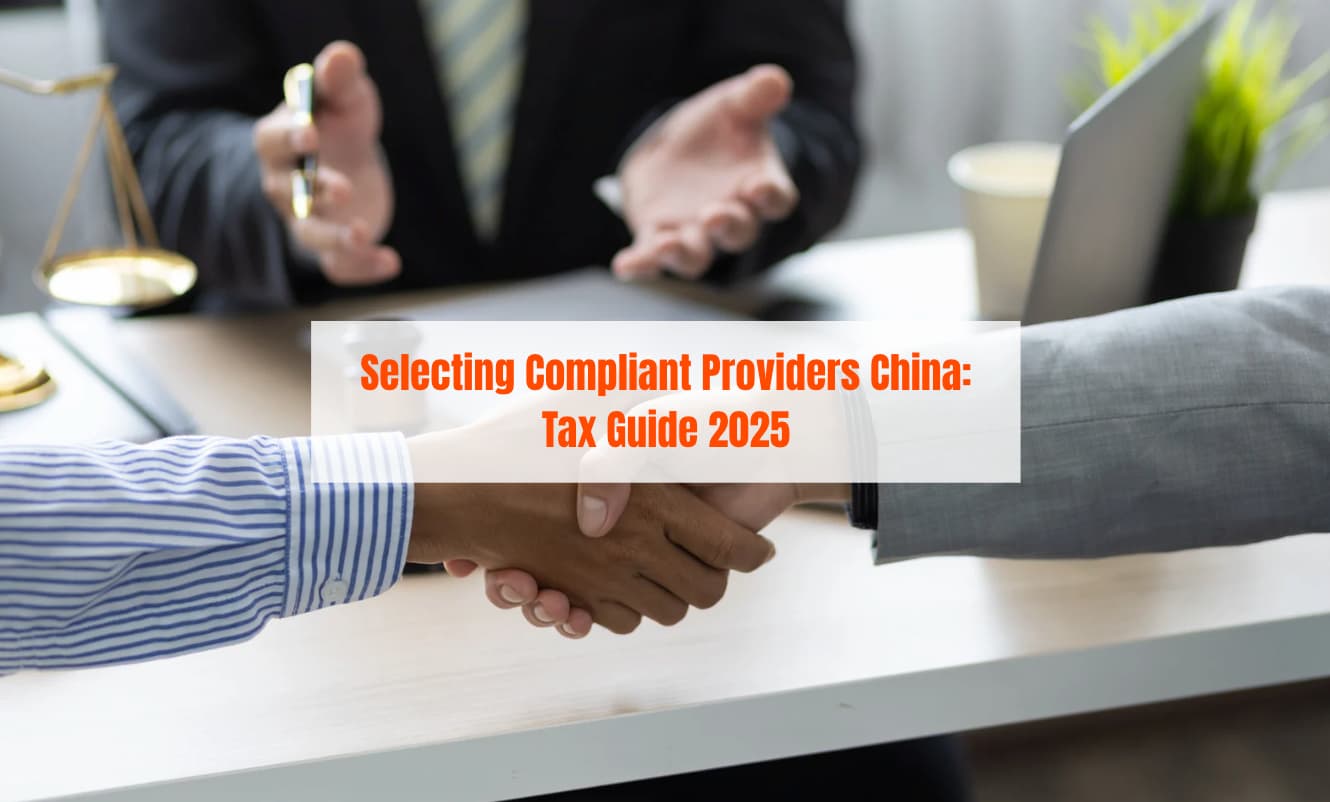Finding the right providers in China just got more complex. New regulations that started in May 2025 changed how you must vet tax service providers through a credit rating system.
Selecting compliant providers in China now requires understanding the Tax Service Credit grading system and verification processes to protect your business from regulatory risks. The new rules cover everything from basic tax filing to specialized audit services.
This guide walks you through the TSC rating system, shows you how to check provider credentials, and gives you practical steps for making wise choices.
You'll learn what red flags to watch for and how to manage ongoing provider relationships under the updated regulations.
Quick Takeaways ⚡:
- From May 1, 2025, China’s Tax Service Regulations 2025 introduce a Tax Service Credit (TSC) system (TSC1 to TSC5) and require provider registration.
- The new framework enforces dynamic credit management, real-time monitoring via QR code, and classified supervision of general vs. specific tax services.
- Providers handling specialized tax audits or authentication must meet additional qualifications and retain full workpapers for regulatory traceability.
- Use official channels to verify TSC rating, historical compliance, and institutional legitimacy—essential for provider selection.
- Best practice: choose TSC3+ for routine services, TSC4/5 + certifications for complex mandates; formalize contracts and monitor credit over time.
📌Also Read: 2025 Import Tax from China to USA: Quick Guide
Overview of the Tax Service Regulations 2025
China's new tax service regulations create a credit-based system for monitoring tax service providers. The framework uses real-time scoring and QR codes to classify providers by risk level.
What Are the New Regulations?
The regulations took effect on May 1, 2025. They establish a structured approach to supervise tax service providers across China.
The system uses risk-based oversight. This means providers with better compliance records face less scrutiny. Those with poor records get more attention from regulators.
Dynamic supervision replaces the old static approach. Your provider's status can change based on their performance. The system updates ratings in real-time.
All tax service providers must register under this new framework. They cannot operate without proper classification. The rules apply to both domestic and foreign companies offering tax services in China.
The TSC Credit System & Classification
Every registered provider gets a unique TSC QR code. You can scan this code to see their current rating. The system shows five levels from TSC5 to TSC1.
TSC Rating Levels:
- TSC5: Highest rating, lowest risk
- TSC4: Good standing
- TSC3: Average performance
- TSC2: Below average, increased monitoring
- TSC1: Lowest rating, highest risk
The system divides services into two categories. General services include basic tax filing and routine compliance work. Specific services cover complex areas like tax authentication and specialized consulting.
Specific service providers need higher credentials. They must meet stricter requirements than general service providers. Your choice of provider should match the complexity of your tax needs.
The QR code system lets you verify provider status instantly. This helps you ensure compliance with regulations when selecting tax service partners.
📌Also Read: Tax Refund in China: A Complete Guide for Tourists & Businesses
Key Compliance Features for Providers

When selecting compliant providers in China, you need to understand two critical systems that directly impact your business operations.
Credit scoring mechanisms track provider performance monthly, while comprehensive documentation requirements ensure regulatory transparency.
Credit Scoring & Supervision
Your provider's credit score updates monthly and resets annually based on multiple performance factors. The scoring system evaluates service quality, client creditworthiness, and strict adherence to real-name registration requirements.
Key scoring components include:
- Service delivery consistency
- Client verification processes
- Regulatory reporting accuracy
- Technical infrastructure reliability
You should monitor your provider's score regularly since it affects their operational privileges. Providers with higher scores receive preferential treatment and expanded service capabilities.
Low scores can restrict your provider's ability to onboard new clients or access certain service features. This directly impacts your business continuity and growth plans.
Workpaper Retention and Audits
Your provider must preserve all documentation for complete traceability during regulatory inspections. This includes transaction records, client verification documents, system logs, and compliance certificates.
Required documentation includes:
- Transaction histories and audit trails
- Client identity verification records
- System security and monitoring logs
- Regulatory correspondence and filings
Violations in documentation standards lead to immediate consequences. Regulators can impose credit score downgrades, financial penalties, or complete license revocation.
You need to verify your provider maintains proper backup systems and document management protocols. Poor record-keeping practices can result in service disruptions that affect your operations without warning.
Regular internal audits help providers identify compliance gaps before regulatory reviews occur.
📌Also Read: How to Verify a Company in China: Full Guide
How to Verify a Provider's TSC Rating
TSC ratings help you confirm a provider's tax compliance status and professional qualifications. The Chinese tax bureau maintains official databases where you can check these ratings directly.
Official Verification Channels
The Tax Services – Publicity of Tax-related Professional Service Institutions platform serves as the primary verification tool for checking provider credentials. You can access this system through the State Taxation Administration's website.
Key verification steps:
- Enter the provider's registration number or company name
- Review their current TSC rating level (A, B, C, or D)
- Check qualification certificates and expiration dates
- Verify compliance history and any penalties
Many certified providers display QR codes on their business materials. You can scan these codes with your smartphone to access their official rating information instantly.
The platform shows real-time data, including:
- Current rating status and effective dates
- Service scope and authorized areas
- Professional staff certifications
- Disciplinary actions or violations
Cross-reference the information with the provider's business license. Legitimate providers will have matching registration details across both systems.
Always verify ratings directly through official channels rather than relying on provider claims or third-party websites.
📌Also Read: Emergency Numbers in China: How to Get Help Fast as a Foreigner
Best Practices for Choosing Providers

Provider selection success depends on matching technical complexity with appropriate qualifications and establishing clear formal agreements. These two factors form the foundation of compliant provider relationships in China.
Matching TSC Levels to Service Complexity
You should select TSC3+ providers for routine tax services like basic filing and standard compliance tasks. These providers handle everyday requirements effectively without unnecessary costs.
For sensitive or technical work, you need TSC4 or TSC5 providers with formal qualifications. This includes:
- Complex tax planning strategies
- International transfer pricing matters
- Merger and acquisition tax structuring
- Dispute resolution with tax authorities
- High-value transaction compliance
TSC4 providers offer specialized expertise for mid-level complexity tasks. They typically have certified tax professionals and established track records.
TSC5 providers provide the highest level of service for the most complex situations. They maintain partnerships with major accounting firms and have extensive regulatory experience.
You can verify provider qualifications through China's tax authority databases. Check their registration status and any disciplinary actions before making final selections.
Formalizing Relations
You must use written agreements that specify exact services, documentation retention periods, and regulatory obligations. Verbal arrangements create compliance risks and unclear accountability.
Your contracts should include these key elements:
- Service scope: Detailed description of all tasks and deliverables
- Documentation requirements: Retention periods and storage methods
- Reporting obligations: When providers must contact tax authorities
- Compliance standards: Specific regulations they must follow
- Liability terms: Clear responsibility for errors or omissions
You should ensure providers report to tax authorities when required by law. Companies are using supplier codes of conduct to maintain compliance standards across their provider networks.
Regular contract reviews help you adapt to changing regulations. Update agreements annually or when new compliance requirements emerge.
📌Also Read: Unified Social Credit Identifier USCI Number in China: Guide
Conclusion
The Tax Service Regulations 2025 set a new benchmark for provider compliance in China. By utilizing the transparent TSC credit system, distinguishing between service types, verifying credentials, and enforcing strong contractual and monitoring practices, companies can confidently select compliant providers in China.
It’s about more than ticking a box, it’s about building a compliance-first relationship that safeguards your tax integrity.
❝For legal support in navigating provider selection and ensuring regulatory compliance in China, you can contact Choi & Partners.❞
FAQs About Selecting Compliant Providers China
Tax service compliance in China requires providers to maintain specific ratings and documentation standards. Understanding TSC ratings, service categories, and record-keeping requirements helps businesses choose qualified tax professionals.
What is "Selecting Compliant Providers China"?
Selecting Compliant Providers China refers to the process of choosing tax service providers who meet China's regulatory standards. These providers must hold valid TSC (Tax Service Compliance) ratings from Chinese tax authorities.
You need compliant providers to handle your business tax obligations legally in China. Non-compliant providers can result in penalties, audit issues, and rejected filings.
The selection process involves checking TSC ratings, verifying credentials, and ensuring providers maintain required documentation standards.
How do I check a provider's TSC rating?
You can verify TSC ratings through the State Administration of Taxation's official website. Enter the provider's registration number or business name in the verification portal.
Current ratings appear as A, B, C, or D classifications. A-rated providers have the highest compliance scores and can handle all tax service types.
Check ratings before signing contracts since they update quarterly. Outdated rating information can lead to choosing providers who no longer meet compliance standards.
What's the difference between general and specific tax services?
General tax services include basic filing, record-keeping, and routine compliance work. Most B-rated and higher providers can perform these standard services.
Specific tax services involve complex transactions like mergers, international transfers, and specialized industry filings. Only A-rated providers with additional certifications can handle these services.
Your business type determines which services you need. Manufacturing and international trade companies typically require specific tax services beyond general compliance.
What documentation must compliant providers retain?
Compliant providers must keep client files for at least 10 years after service completion. This includes all tax calculations, supporting documents, and correspondence with tax authorities.
Electronic records must have backup systems and security measures meeting Chinese data protection standards. Physical documents require secure storage with access controls.
Providers must produce these records during tax audits or authority requests. Failure to maintain proper documentation can result in rating downgrades or license suspension.
What if a provider's TSC rating drops?
You must find a new provider if your current provider's rating drops below acceptable levels for your service needs. Continue using downgraded providers at your own compliance risk.
TSC ratings drop due to filing errors, missed deadlines, or regulatory violations. Providers have 90 days to appeal rating changes through formal review processes.
Monitor your provider's rating quarterly through official channels. Early detection of rating issues gives you time to transition services without disrupting your tax compliance schedule.
Subscribe to receive updates
Subscribe to receive the latest blog posts to your inbox every week.



